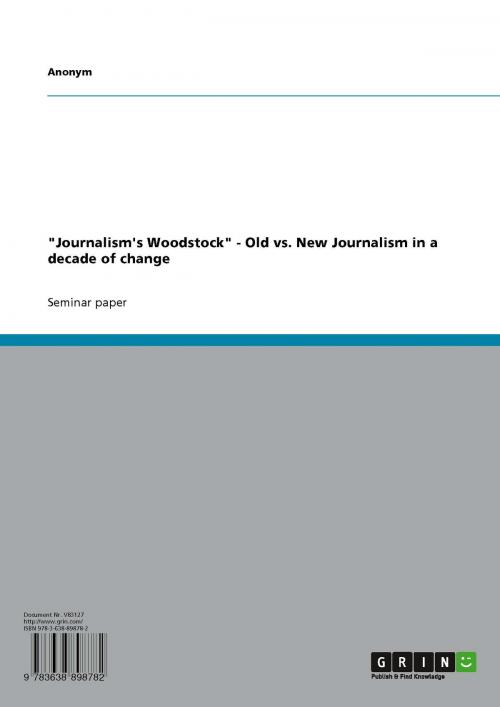'Journalism's Woodstock' - Old vs. New Journalism in a decade of change
Old vs. New Journalism in a decade of change
Nonfiction, Reference & Language, Language Arts, Journalism| Author: | Anonymous | ISBN: | 9783638898782 |
| Publisher: | GRIN Publishing | Publication: | January 22, 2008 |
| Imprint: | GRIN Publishing | Language: | English |
| Author: | Anonymous |
| ISBN: | 9783638898782 |
| Publisher: | GRIN Publishing |
| Publication: | January 22, 2008 |
| Imprint: | GRIN Publishing |
| Language: | English |
Seminar paper from the year 2007 in the subject Communications - Journalism, Journalism Professions, grade: 1,7, University of Hannover (Englisches Seminar), 10 entries in the bibliography, language: English, abstract: New Journalism caused a sensation in the turbulent 1960s when young American writers - both journalists and novelists - began to blur the lines between fact and fiction. The traditional rules defining journalism and literature did not exist anymore - at least in the heads of many new journalists. Tom Wolfe, Truman Capote, Norman Mailer, Joan Didion, and Hunter S. Thompson were only a few of many representatives who raised a heated discussion about the obligation to be objective in print journalism. Notwithstanding, the turning away from the impersonal, almost clinical news journalism and the shift towards an authentic, emotional, yet nonfictional style of writing reflected the atmosphere of the 60s and 70s in America. The paper sets out to explore the phenomenon of New Journalism, its techniques, as well as its meaning within the decade of its emergence. In order to give an insight into the self-conception of New Journalists, their research strategies will be explained exemplarily. Furthermore, traditional journalistic techniques will be further elaborated and compared to those of New Journalism. How do newspaper journalists work and write? What principles underlie their writing and how did these rules evolve in the first place? Chapter 2 gives answers to these questions. Finally, claiming objectivity to be the absolute when it comes to representing the truth, is questionable. Rather, both Old and New Journalism can sensibly complement each other.
Seminar paper from the year 2007 in the subject Communications - Journalism, Journalism Professions, grade: 1,7, University of Hannover (Englisches Seminar), 10 entries in the bibliography, language: English, abstract: New Journalism caused a sensation in the turbulent 1960s when young American writers - both journalists and novelists - began to blur the lines between fact and fiction. The traditional rules defining journalism and literature did not exist anymore - at least in the heads of many new journalists. Tom Wolfe, Truman Capote, Norman Mailer, Joan Didion, and Hunter S. Thompson were only a few of many representatives who raised a heated discussion about the obligation to be objective in print journalism. Notwithstanding, the turning away from the impersonal, almost clinical news journalism and the shift towards an authentic, emotional, yet nonfictional style of writing reflected the atmosphere of the 60s and 70s in America. The paper sets out to explore the phenomenon of New Journalism, its techniques, as well as its meaning within the decade of its emergence. In order to give an insight into the self-conception of New Journalists, their research strategies will be explained exemplarily. Furthermore, traditional journalistic techniques will be further elaborated and compared to those of New Journalism. How do newspaper journalists work and write? What principles underlie their writing and how did these rules evolve in the first place? Chapter 2 gives answers to these questions. Finally, claiming objectivity to be the absolute when it comes to representing the truth, is questionable. Rather, both Old and New Journalism can sensibly complement each other.















